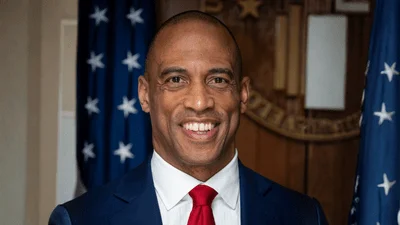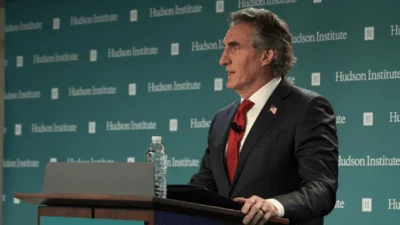The Congressional Record is a unique source of public documentation. It started in 1873, documenting nearly all the major and minor policies being discussed and debated.
“THE FEDERAL RESERVE'S PRICING PRACTICES” mentioning the Federal Reserve System was published in the House of Representatives section on pages H411-H412 on Feb. 11, 1998.
The publication is reproduced in full below:
THE FEDERAL RESERVE'S PRICING PRACTICES
The SPEAKER pro tempore. Under a previous order of the House, the gentlewoman from New York (Mrs. Maloney) is recognized for 5 minutes.
Mrs. MALONEY of New York. Mr. Speaker, the events of recent years have taught us time and again that we should rely as much as possible on the private sector functioning in the competitive marketplace to provide commercial-type services, particularly services sold to business firms.
Where there is a Federal agency that provides those types of services, we must closely examine its activities to determine if it is competing fairly with its private-sector competitors. This becomes more important when the agency both competes directly with private-sector firms and regulates those competitors.
Mr. Speaker, the Federal Reserve is using its role as competitor and regulator in the check processing system to unfairly undercut the private sector. They are using an accounting device called the
``pension cost credit'' to subsidize the prices they charge banks, resulting in an unfair handicap to the private sector.
When people hear the phrase ``Federal Reserve,'' they think about interest rates, inflation, and other aspects of monetary policy. However, the Fed is not just about monetary policy and banking supervision. Much of what the Fed does simply involves the processing of paper checks. The Fed charges its banks a fee for the service it provides.
In 1980, Congress passed the Monetary Control Act so that private sector companies could fairly compete with the Federal Reserve in providing banks with these and other services. Accordingly, the Fed must fully recover the cost of its services, which means it cannot use subsidized prices.
The Act specifically orders the Fed to establish the prices it charges based on the costs which it incurs in providing its services plus the costs a private company would also have to consider, such as the taxes it would have to pay.
But instead of following the intent of the Monetary Control Act, the Federal Reserve is using the ``pension cost credit'' to lower the prices it charges banks for these services. That is, it is effectively using a portion of the large surplus in its pension fund to reduce the operating costs of its priced service activities, which in turn enables it to charge lower prices than it otherwise would.
Let me explain specifically how it works. At the end of 1996, the pension fund for the employees of the Federal Reserve System had excess funding of $1.9 billion. This incredible excess, nearly double its pension liability, is due primarily to the so-called irrational exuberance of the stock market.
The Fed then uses an accounting device to effectively take a portion of this excess funding in the pension fund to create an expense offset. This is the pension cost credit.
Instead of sending the whole of this cost credit back to the Treasury, the Fed uses approximately one-third of it to reduce the expenses of its priced services. That reduction then allows the Fed to charge lower prices than it otherwise would.
Mr. Speaker, I submit for the Record a letter that Federal Reserve Vice-Chairwoman, Alice Rivlin, sent to me.
The letter referred to is as follows:
Board of Governors of the
Federal Reserve System,
Washington, DC, October 3, 1997.Hon. Carolyn B. Maloney,House of RepresentativesWashington, DC.
Dear Carolyn: I am pleased to forward additional materials in response to your letter of September 5 regarding payments system issues. Please let me know if I can be of further assistance.
Sincerely,
Alice M. Rivlin,
Vice Chairman.
Enclosures.
Federal Reserve Board Staff's Additional Responses to Congresswoman
Maloney's September 5, 1997, Questions
1. Please send a monthly record of ITS cost-recovery matching before and after the application of the private sector adjustment factor for the years 1990 to date.
Internal reports from the Federal Reserve Bank of Boston that showed monthly cost recovery numbers for 1987 through early 1995 were enclosed with Chairman Greenspan's letter of April 28, 1995, to Congressman Gonzalez.
Attachment 1 shows monthly cost recovery for commercial check portion of the ITS network from 1995 through the first half of 1997. The Federal Reserve does not typically allocate imputed costs and revenues to input components of its services. As requested, the cost recovery data are shown with and without imputed expenses.
2. Please supply a breakdown of prices services income, by Federal Reserve Bank for 1996. The breakdown should include revenue by specific commercial check product, such as NCS, RCPC, fine sort, consolidated shipments, and direct sends.
The priced services income for 1996 and the first two quarters of 1997, which you requested in question 5, was provided in Vice Chair Rivlin's letter of September 16, 1997.
Attachment 2 shows the Reserve Banks' revenues for the Reserve Bank check products you requested. Revenue for consolidated shipments includes only transportation revenues based on ITS surcharges. Consolidated shippers, that is, banks that use ITS to ship checks to a nonlocal Reserve Bank office for processing, use a wide variety of checks products. We do not separately track and identify the products into which these shipments are deposited and, therefore, cannot provide the associated revenue data. Similarly, we do not separately track the check processing revenue associated with
``direct send'' deposits shipped to the Reserve Banks by banks that arrange for their own transportation.
3. How is the Federal Reserve's pension cost credit
($140.57 million for 1996) reflected in (a) measurement of priced services profitability and (b) in the pricing of specific priced services, such as check processing and transportation? What accounts for the $63 million difference in 1996 between operating expenses for priced services, as reported on page 271 of the 1996 Annual Report of the Board of Governors and the sum of the operating expenses reported in the 1996 PACS Expense report. Please supply financial reports for the Federal Reserve pension plan(s) for 1992 through 1996.
The System endeavors to capture all of its costs applicable to the provision of priced services into its pricing formula and measurements of its profitability through explicit recognition in the Reserve Banks' cost accounting systems or through implicit allocations where appropriate. For transactions relating to the provision of priced services, the Federal Reserve System applies generally accepted accounting practices (GAAP). Prior to changes in GAAP in 1987 and 1993 for employers accounting for pensions and retiree medical benefits, respectively, the System accounted for these costs on a cash, or ``pay as you go'' basis. The System, like other services providers, changed accounting practices to conform to GAAP. This change resulted in the recognition of a pension asset that generates net credits and a retiree medical liability that generates net expenses for the System.
As with any accounting change, the System compared the effect of the GAAP changes with the effect on the largest bank holding companies used in determining the PSAF. We believe that the System's pricing formula properly recognizes the effect of these changes to GAAP. My staff can provide you or your staff with additional detail on the technical issues involved with these GAAP changes at your convenience.
The table below shows a reconciliation, for 1996, of operating expenses as reported in PACS with the pro forma financial statement in the Federal Reserve's 1996 Annual Report.
PACS Expense to Pro Forma Expenses for 1996
PACS operating expenses (Millions)
Cash (3020)........................................................$5.1
Funds (3250).......................................................71.6
ACH (3260).........................................................83.9
Check (3360)......................................................551.4
Book-Entry (3520)..................................................43.3
Non-Cash (3810).....................................................4.6
________
Total PACS expenses.........................................760.0
Less non-priced costs............................................(51.5)
________
Priced PACS costs...........................................708.5
========
Pro forma items not in PACS:
*Proceed pension credit.....................................(45.3)*
Imputed Board expenses..........................................2.8
________
Total items not in PACS....................................(42.5)
========
Pro forma operating expenses................................666.0
The letter shows that, in 1996, the pension cost credit was $45.3 million.
This is $45 million of taxpayer money which the Fed should have returned to the Treasury, but instead, it used this sum to artificially cut its prices. This is $45 million which, instead of going towards deficit reduction, went to help the Fed undercut its private sector competitors, many of whom they also regulate.
Any other agency of the government cannot justify using a pension cost credit to subsidize their own prices.
Mr. Speaker, as the only source of oversight for the Federal Reserve, Congress has a duty to police this activity in the Federal Reserve.
We must recognize that there is inherent conflict with the Fed being both the regulator and the largest competitor in check processing. This is why we need to pass legislation which clarifies the Fed's role and relationship with the private sector, such as my own bipartisan bill, H.R. 2119, ``The Efficient Check Clearing Act.''
{time} 1930
The SPEAKER pro tempore (Mr. Ney). Under a previous order of the House, the gentleman from Alabama (Mr. Riley) is recognized for 5 minutes.
(Mr. RILEY addressed the House. His remarks will appear hereafter in the Extensions of Remarks.)
____________________








